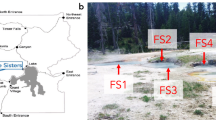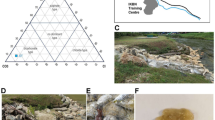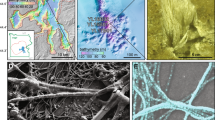Abstract
Understanding how microbial communities respond and adjust to ecosystem perturbation is often difficult to interpret due to multiple and often simultaneous variations in observed conditions. In this research, we investigated the microbial community dynamics of Inferno Crater Lake, an acidic geothermal spring in New Zealand with a unique thermal cycle that varies between 30 and 80 °C over a period of 40–60 days. Using a combination of next-generation sequencing, geochemical analysis and quantitative PCR we found that the microbial community composition was predominantly chemolithotrophic and strongly associated with the thermal cycle. At temperatures >65 °C, the microbial community was dominated almost exclusively by sulphur-oxidising archaea (Sulfolobus-like spp.). By contrast, at mesophilic temperatures the community structure was more mixed, comprising both archaea and bacteria but dominated primarily by chemolithotrophic sulphur and hydrogen oxidisers. Multivariate analysis of physicochemical data confirmed that temperature was the only significant variable associated with community turnover. This research contributes to our understanding of microbial community dynamics in variable environments, using a naturally alternating system as a model and extends our limited knowledge of acidophile ecology in geothermal habitats.
Similar content being viewed by others
Log in or create a free account to read this content
Gain free access to this article, as well as selected content from this journal and more on nature.com
or
References
Bacchetti De Gregoris T, Aldred N, Clare AS, Burgess JG . (2011). Improvement of phylum- and class-specific primers for real-time PCR quantification of bacterial taxa. J Microbiol Methods 86: 351–356.
Barber RD . (2001) Methanogenesis: Ecology eLS. John Wiley & Sons Ltd.: Chichester, England, pp 1–9.
Bohorquez LC, Delgado-Serrano L, Lopez G, Osorio-Forero C, Klepac-Ceraj V, Kolter R et al. (2012). In-depth characterization via complementing culture-independent approaches of the microbial community in an acidic hot spring of the Colombian Andes. Microb Ecol 63: 103–115.
Boone DR . (2001) Class I. Methanobacteria class. nov. In: Boone DR, Castenholz RW (eds). Bergy's Manual of Systematic Bacteriology. Springer: New York, NY, pp 213–218.
Cadillo-Quiroz H, Brauer S, Yashiro E, Sun C, Yavitt J, Zinder S . (2006). Vertical profiles of methanogenesis and methanogens in two contrasting acidic peatlands in central New York State, USA. Environ Microbiol 8: 1428–1440.
Caporaso JG, Lauber CL, Walters WA, Berg-Lyons D, Lozupone CA, Turnbaugh PJ et al. (2011). Global patterns of 16 S rRNA diversity at a depth of millions of sequences per sample. Proc Natl Acad Sci USA 108: 4516–4522.
Cheng L, Dai LR, Li X, Zhang H, Lu YH . (2011). Isolation and characterization of Methanothermobacter crinale sp. nov., a novel hydrogenotrophic methanogen from the Shengli Oil Field. Appl Environ Microbiol 77: 5212–5219.
Clark K, Gorley R . (2006) PRIMER v6: User Manual/Tutorial. PRIMER-E: Plymouth.
Donahoe-Christiansen J, D'imperio S, Jackson CR, Inskeep WP, Mcdermott TR . (2004). Arsenite-oxidizing Hydrogenobaculum strain isolated from an acid-sulfate-chloride geothermal spring in Yellowstone National Park. Appl Environ Microbiol 70: 1865–1868.
Dopson M, Johnson DB . (2012). Biodiversity, metabolism and applications of acidophilic sulfur-metabolizing microorganisms. Environ Microbiol Rep 14: 2620–2631.
Edgar RC, Haas BJ, Clemente JC, Quince C, Knight R . (2011). UCHIME improves sensitivity and speed of chimera detection. Bioinformatics 27: 2194–2200.
Geonet. (2001) The Geonet Project [Online]. Available at https://www.geonet.org.nz/. Retrieved: 2013.
Giggenbach WF . (1995). Variations in the chemical and isotopic composition of fluids discharged from the Taupo Volcanic Zone, New Zealand. J Volcanol Geoth Res 68: 89–116.
Gilbert JA, Steele JA, Caporaso JG, Steinbruck L, Reeder J, Temperton B et al. (2012). Defining seasonal marine microbial community dynamics. ISME J 6: 298–308.
Glover RB, Stewart MK, Crump ME, Klyen LE, Simmons SF . (1994). The relationship of chemical parameters to the cyclic behavior of Inferno Crater Lake, Waimangu, New Zealand. Geothermics 23: 583–597.
Hallberg KB, Johnson DB . (2001). Biodiversity of acidophilic prokaryotes. Adv Appl Microbiol 49: 37–84.
Hallberg KB, Lindstrom EB . (1994). Characterization of Thiobacillus caldus sp. nov., a moderately thermophilic acidophile. Microbiology 140: 3451–3456.
Hedlund BP, Cole JK, Williams AJ, Hou W, Zhou E, Li W et al. (2012). A review of the microbiology of Rehai geothermal field in Tengchong, Yunnan Province, China. Geosci Front 3: 273–288.
Huber H, Stetter KO . (2001) Genus I. Sulfolobus. In: Boone DR, Castenholz RW (eds). Bergy's Manual of Systematic Bacteriology. Springer: New York, NY, pp 198–201.
Inskeep WP, Jay ZJ, Herrgard MJ, Kozubal MA, Rusch DB, Tringe SG et al. (2013). Phylogenetic and functional analysis of metagenome sequence from high-temperature archaeal habitats demonstrate linkages between metabolic potential and geochemistry. Front Microbiol 4: 95.
Inskeep WP, Rusch DB, Jay ZJ, Herrgard MJ, Kozubal MA, Richardson TH et al. (2010). Metagenomes from high-temperature chemotrophic systems reveal geochemical controls on microbial community structure and function. Plos One 5: e9773.
Justice NB, Norman A, Brown CT, Singh A, Thomas BC, Banfield JF . (2014). Comparison of environmental and isolate Sulfobacillus genomes reveals diverse carbon, sulfur, nitrogen, and hydrogen metabolisms. BMC Genomics 15: 1107.
Kato S, Itoh T, Yamagishi A . (2011). Archaeal diversity in a terrestrial acidic spring field revealed by a novel PCR primer targeting archaeal 16 S rRNA genes. FEMS Microbiol Lett 319: 34–43.
Keam RF . (1981) Inferno Crater Lake - Provisional Bathymetry 1:250. N.Z. Oceanographic Institute, DSIR.
Keywood M, Nicholson K . (1990). Cyclic and temporal changes in water chemistry of Inferno Crater Lake, Waimangu geothermal valley, New Zealand. In: Harvey CC, Browne PRL, Freeston DH, Scott GL (eds), Proceedings of the 12th New Zealand Geothermal Workshop, Auckland. Geothermal Institute, pp 103-110.
Koenig JE, Spor A, Scalfone N, Fricker AD, Stombaugh J, Knight R et al. (2011). Succession of microbial consortia in the developing infant gut microbiome. Proc Natl Acad Sci USA 108: 4578–4585.
Kondrat’eva TF, Pivovarova TA, Tsaplina IA, Fomchenko NV, Zhuravleva AE, Murav’ev MI et al. (2012). Diversity of the communities of acidophilic chemolithotrophic microorganisms in natural and technogenic ecosystems. Microbiology 81: 1–24.
Liu Y, Whitman WB . (2008). Metabolic, phylogenetic, and ecological diversity of the methanogenic archaea. Ann NY Acad Sci 1125: 171–189.
Mardanov AV, Gumerov VM, Beletsky AV, Perevalova AA, Karpov GA, Bonch-Osmolovskaya EA et al. (2011). Uncultured archaea dominate in the thermal groundwater of Uzon Caldera, Kamchatka. Extremophiles 15: 365–372.
Meyer-Dombard D, Shock EL, Amend JP . (2005). Archaeal and bacterial communities in geochemically diverse hot springs of Yellowstone National Park, USA. Geobiology 3: 211–227.
Op Den Camp HJ, Islam T, Stott MB, Harhangi HR, Hynes A, Schouten S et al. (2009). Environmental, genomic and taxonomic perspectives on methanotrophic Verrucomicrobia. Environ Microbiol Rep 1: 293–306.
Prokofeva MI, Kublanov IV, Nercessian O, Tourova TP, Kolganova TV, Lebedinsky AV et al. (2005). Cultivated anaerobic acidophilic/acidotolerant thermophiles from terrestrial and deep-sea hydrothermal habitats. Extremophiles 9: 437–448.
Quince C, Lanzen A, Davenport RJ, Turnbaugh PJ . (2011). Removing noise from pyrosequenced amplicons. BMC Bioinformatics 12: 38.
Romano C, D'imperio S, Woyke T, Mavromatis K, Lasken R, Shock EL et al. (2013). Comparative genomic analysis of phylogenetically closely related Hydrogenobaculum sp. isolates from Yellowstone National Park. Appl Environ Microbiol 79: 2932–2943.
Sahm K, John P, Nacke H, Wemheuer B, Grote R, Daniel R et al. (2013). High abundance of heterotrophic prokaryotes in hydrothermal springs of the Azores as revealed by a network of 16 S rRNA gene-based methods. Extremophiles 17: 649–662.
Schloss PD, Gevers D, Westcott SL . (2011). Reducing the effects of PCR amplification and sequencing artifacts on 16 S rRNA-based studies. PLoS One 6: e27310.
Scott BJ . (1994). Cyclic activity in the crater lakes of Waimangu Hydrothermal System, New Zealand. Geothermics 23: 555–572.
Shade A, Caporaso JG, Handelsman J, Knight R, Fierer N . (2013). A meta-analysis of changes in bacterial and archaeal communities with time. ISME J 7: 1493–1506.
Shade A, Peter H, Allison SD, Baho DL, Berga M, Burgmann H et al. (2012). Fundamentals of microbial community resistance and resilience. Front Microbiol 3: 417.
Sharma A, Kawarabayasi Y, Satyanarayana T . (2012). Acidophilic bacteria and archaea: acid stable biocatalysts and their potential applications. Extremophiles 16: 1–19.
She Q, Singh RK, Confalonieri F, Zivanovic Y, Allard G, Awayez MJ et al. (2001). The complete genome of the crenarchaeon Sulfolobus solfataricus P2. Proc Natl Acad Sci USA 98: 7835–7840.
Sheppard DS . (1986). Fluid chemistry of the Waimangu geothermal system. Geothermics 15: 309–328.
Shima S, Yanagi M, Saiki H . (1994). The phylogenetic position of Hydrogenobacter acidophilus based on 16 S rRNA sequence analysis. FEMS Microbiol Lett 119: 119–122.
Siering PL, Clarke JM, Wilson MS . (2006). Geochemical and biological diversity of acidic, hot springs in Lassen Volcanic National Park. Geomicrobiol J 23: 129–141.
Simmons SF, Browne M, Robinson BW, Clover RB . (1994). The chemical and isotopic compositions of thermal waters at Waimangu, New Zealand. Geothermics 23: 539–553.
Simmons SF, Keywood M, Scott BJ, Keam RF . (1993). Irreversible change of the Rotomahana-Waimangu Hydrothermal System (New-Zealand) as a consequence of a volcanic-eruption. Geology 21: 643–646.
Sizova MV, Panikov NS, Tourova TP, Flanagan PW . (2003). Isolation and characterization of oligotrophic acido-tolerant methanogenic consortia from a Sphagnum peat bog. FEMS Microbiol Ecol 45: 301–315.
Stohr R, Waberski A, Volker H, Tindall BJ, Thomm M . (2001). Hydrogenothermus marinus gen. nov., sp nov., a novel thermophilic hydrogen-oxidizing bacterium, recognition of Calderobacterium hydrogenophilum as a member of the genus Hydrogenobacter and proposal of the reclassification of Hydrogenobacter acidophilus as Hydrogenobaculum acidophilum gen. nov., comb. nov., in the phylum 'Hydrogenobacter/Aquifex'. Int J Syst Evol Microbiol 51: 1853–1862.
Stout LM, Blake RE, Greenwood JP, Martini AM, Rose EC . (2009). Microbial diversity of boron-rich volcanic hot springs of St. Lucia, Lesser Antilles. FEMS Microbiol Ecol 70: 402–412.
Stucker VK, De Ronde CEJ, Scott BJ, Wilson NJ, Walker SL, Lupton JE . (2016). Subaerial and sublacustrine hydrothermal activity at Lake Rotomahana. J Volcanol Geoth Res 314: 156–168.
Suzuki T, Iwasaki T, Uzawa T, Hara K, Nemoto N, Kon T et al. (2002). Sulfolobus tokodaii sp. nov. (f. Sulfolobus sp strain 7), a new member of the genus Sulfolobus isolated from Beppu Hot Springs, Japan. Extremophiles 6: 39–44.
Takai K, Horikoshi K . (2000). Rapid detection and quantification of members of the archaeal community by quantitative PCR using fluorogenic probes. Appl Environ Microbiol 66: 5066–5072.
Tringe SG, Hugenholtz P . (2008). A renaissance for the pioneering 16 S rRNA gene. Curr Opin Microbiol 11: 442–446.
Valdes J, Pedroso I, Quatrini R, Dodson RJ, Tettelin H, Blake R 2nd et al. (2008). Acidithiobacillus ferrooxidans metabolism: from genome sequence to industrial applications. BMC Genomics 9: 597.
Valentine DL . (2007). Adaptations to energy stress dictate the ecology and evolution of the Archaea. Nat Rev Microbiol 5: 316–323.
Vandemeulebrouck J, Hurst AW, Scott BJ . (2008). The effects of hydrothermal eruptions and a tectonic earthquake on a cycling crater lake (Inferno Crater Lake, Waimangu, New Zealand). J Volcanol Geoth Res 178: 271–275.
Wertz S, Degrange V, Prosser JI, Poly F, Commeaux C, Guillaumaud N et al. (2007). Decline of soil microbial diversity does not influence the resistance and resilience of key soil microbial functional groups following a model disturbance. Environ Microbiol Rep 9: 2211–2219.
Acknowledgements
We acknowledge the New Zealand GeoNet Project and its sponsors EQC, GNS Science and LINZ, for providing data/images used in this study. This project was supported by the GNS Science DCF programme, Geothermal Resources of New Zealand. We also thank Harvey and Trudi of Waimangu Volcanic Valley for access and their ongoing support for this project.
Author information
Authors and Affiliations
Corresponding author
Ethics declarations
Competing interests
The authors declare no conflict of interest.
Additional information
Supplementary Information accompanies this paper on The ISME Journal website
Supplementary information
Rights and permissions
About this article
Cite this article
Ward, L., Taylor, M., Power, J. et al. Microbial community dynamics in Inferno Crater Lake, a thermally fluctuating geothermal spring. ISME J 11, 1158–1167 (2017). https://doi.org/10.1038/ismej.2016.193
Received:
Revised:
Accepted:
Published:
Issue date:
DOI: https://doi.org/10.1038/ismej.2016.193
This article is cited by
-
Covariation of hot spring geochemistry with microbial genomic diversity, function, and evolution
Nature Communications (2024)
-
Bacterial and archaeal community distributions and cosmopolitanism across physicochemically diverse hot springs
ISME Communications (2023)
-
Prokaryotes of renowned Karlovy Vary (Carlsbad) thermal springs: phylogenetic and cultivation analysis
Environmental Microbiome (2022)
-
Microbial diversity in extreme environments
Nature Reviews Microbiology (2022)
-
Prokaryotic diversity across a pH gradient in the “El Chichón” crater-lake: a naturally thermo-acidic environment
Extremophiles (2022)



